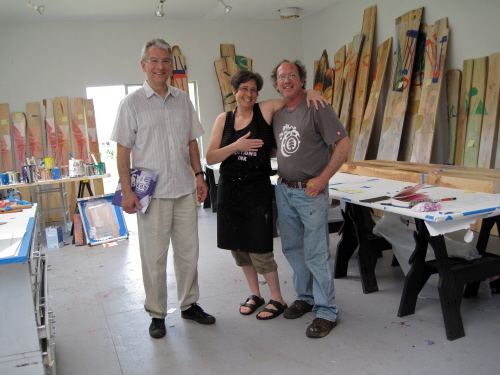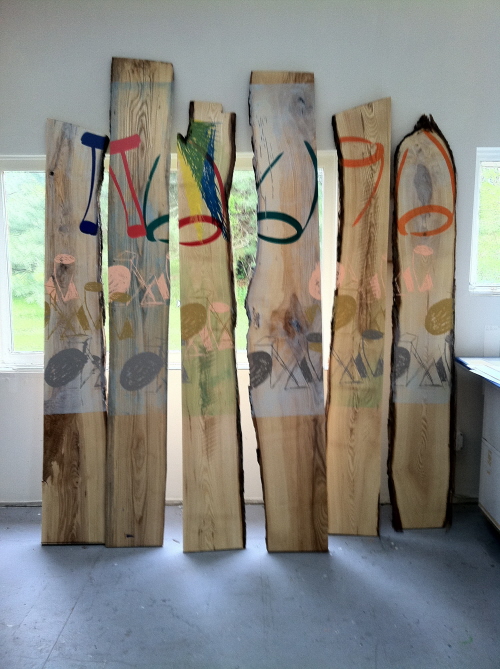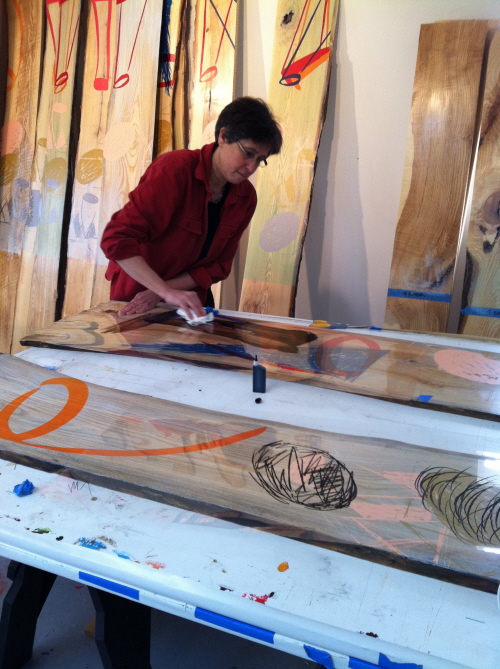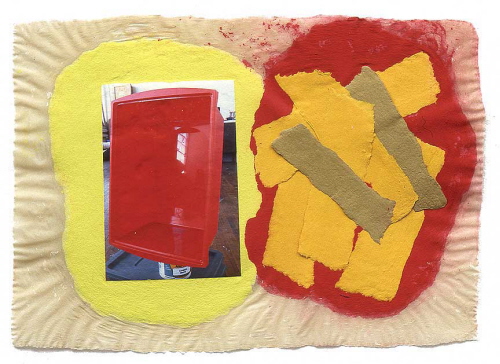
From left: Richard Klein, Jessica Stockholder, and Gary Lichtenstein at Gary Lichtenstein Editions. Courtesy Gary Lichtenstein Editions.
Following on the April post for this column, which explored recent works in print-based installation, this month’s Ink takes an in-depth look at Art21 artist Jessica Stockholder’s current project for The Aldrich Contemporary Art Museum in Ridgefield, Connecticut. Printmaking — specifically screenprinting – plays a unique and significant role in the final work, titled Hollow Places Court in Ash-Tree Wood. To create this installation, Stockholder collaborated with master printer Gary Lichtenstein of Gary Lichtenstein Editions and furniture-maker Clifford Moran to transform rough-hewn planks of ash wood.
In a break from standard nomenclature, Stockholder refers to Hollow Places Court in Ash-Tree Wood as a “situation” – a term she uses to describe a built environment comprised of pre-composed elements that she places in response to the unique features of a specific space. The artist prefers this word to “installation,” which she finds somewhat overused and generic. It is also meant to differentiate between other discrete approaches in her work, namely her site-specific installations, in which she composes diverse found objects and materials on site (also in response to the space at hand) and her studio works, which are self-contained objects.
The seed for this project began in 2009, when the Aldrich was forced to cut a large centenarian ash tree that stood in its sculpture garden due to infestation from the emerald ash borer, an invasive Asian beetle. Thinking that it would receive new life in the hands of a contemporary artist, the museum sent the tree to a mill and stored the planks to cure for future use. In a recent conversation, exhibition curator and Interim Co-Director of the museum Richard Klein related that the idea of offering the planks to Stockholder – who has worked primarily with man-made and mass produced materials in the past – came about when he was speaking with her about doing an installation at the Aldrich. He mentioned the incident with the ash tree to her as an aside and was pleasantly surprised to learn that she had a deep connection with trees and wood due to her experience growing up in the Pacific Northwest Coast. She spoke of the lush rainforest surroundings populated with old-growth trees and her first memories of sculptures: wood-carved totem poles created by the indigenous peoples of the area. Though the staff at the museum had originally thought to give the wood to an artist known for working with the material, Klein realized that it might be more interesting to see what an artist like Stockholder would do with the planks.
Stockholder, who has recently been drawn to opportunities that present unusual and new circumstances which allow her to stretch her artistic practice (see, for example, two recent exhibitions: Flooded Chambers Maid, Madison Square Park; and The Jewel Thief, Tang Museum and Sculpture Garden), was greatly intrigued and quickly provided a proposal to Klein. In Stockholder’s words, the project is a meditation on the nature of “picture-making and seeing.” It incorporates a repeating eye-like motif, which suggests to the process of looking and what Stockholder calls the “frame of the eye,” or the perspective from which we view the world, which is echoed by the windows of the museum gallery that “frame” the sculpture garden, where the tree once stood. The eye concept was also inspired by the prominent use of eyes in the wood carvings of First Nations peoples of the Pacific Northwest. The result is a provocative intersection of Stockholder’s two-dimensional and three-dimensional modes of working, which she characterizes as “creating fiction” and “a response to the mundane, matter-of-fact quality of objects,” respectively.
Over the coming weeks, Hollow Places Court in Ash-Tree Wood will be installed in two galleries within the museum. In accordance with Stockholder’s mode of working, specifics will develop organically as it is installed, but some parameters have already been established. One gallery will house two wooden folding screens titled Hollow Places Thin and Hollow Places Fat. Created in collaboration with Clifford Moran, a Ridgefield-based furniture maker, the finished screens were painted by Stockholder. They will interact with a large, bluish-purple form suspended from the ceiling. Convex oval driveway mirrors will reflect the various elements of the installation and the surrounding galleries.

Completed screenprinted ash-wood planks at Gary Lichtenstein Editions. Courtesy Gary Lichtenstein Editions.
A second gallery will contain groupings of ash planks that have been screenprinted in various color combinations with Stockholder’s drawings. When aligned against the wall, the printed coalesce to roughly correspond to the shape of the windows in the gallery where they will be placed. The natural contours, flaws, and bark of the tree were preserved at the edges of the planks and the grain patterns and untreated freshness of the wood was left untouched in the unprinted areas. The order will be established in response to the gallery space during installation. Stockholder’s man-made — yet free-flowing and organic – screened drawings will present a foil to the natural world that is framed by the windows and invite meditation on the relationship between the two.

Stockholder and Lichtenstein at work in the studio. Courtesy Gary Lichtenstein Editions.
To print on the boards, Stockholder collaborated with Gary Lichtenstein of Gary Lichtenstein Editions, also in Ridgefield. To begin, she drew a number of abstract forms in response to the organic forms embodied in the planks. As an artist who has traditionally worked with man-made materials, Stockholder found herself taken in by the “romantic” attributes of the wood – a quality that Lichtenstein also found compelling, though neither of them is particularly inclined that way. Lichtenstein next created screens from her drawings and they consulted on the technical aspects of achieving the desired effect. The screened shapes were then printed to the boards in varying configurations and colors. Stockholder also applied inks by hand in selected areas.

Stockholder hand-applying ink to the planks. Courtesy Gary Lichtenstein Editions.
The boards are grouped in clusters that are related by shape and palette. As the project developed, Stockholder was interested in the contrast between “pattern-making and systems” that are inherent in the printmaking process and “the eccentricity of the gesture” embodied in the drawings she created for the screens. She felt that it was important to bring attention to the intersection between these right- and left-brain modalities in the work. Her answer was to assign a letter designation to each group that would be printed on each plank in a nod to the rational thought process that gives structure to the wilder, intuitive qualities of the imagery and the wood itself.
Another dimension that informed Stockholder’s thinking on this project was the subjective notion of time that is embodied in the tree’s rings. In Stockholder’s words, “trees are slow growers, yet they are alive and responsive…the life of a tree is often much longer than our own time as humans.” This alternative sense of time stands in contrast to the short-lived nature of the exhibition, as well as the even more abbreviated period that viewers will spend with the work on an individual basis.
Stockholder sees a “musical quality” in the final product – a rhythmic undercurrent that is emphasized by the repetition of the boards, the spaces between, and the cadence of the printed shapes, some of which recall notes. Also, the very process of screening the boards – a choreographed and repetitive action — echoed these qualities in the work.
Stockholder’s process of collaboration with Lichtenstein and Moran also brings up “the question of craft and how and why it matters. The term has become problematic in contemporary art but it is important nonetheless.” It is clear that craft plays a role in the creative process for all three of them, but the degree to which it is pursued varies. At one end of the spectrum, Stockholder’s attitude is that “craft suits the end” – an approach that comes from her training in painting. Lichtenstein – who is a painter as well as a master screenprinter – is open to experimentation, but also retains a strict fidelity to the technical demands of screenprinting on the level of a master printer. Moran, who studied furniture design at the Rhode Island School of Design, is a consummate technician who places craftsmanship at the center of his creative work. Stockholder felt it was a great privilege to work collaboratively with both artists and take advantage of their expertise in a “meeting of the minds.”

Jessica Stockholder, "Red Tube + Two,” 2005. Pigmented abaca base sheet with pulp painting and archival inkjet print, 11 X 14 inches. Courtesy the artist and Dieu Donné Papermill, New York.
Outside of their collaboration for the Aldrich, Stockholder and Lichtenstein are also working on a separate series of monoprints as well as an edition. Though Stockholder created a few screenprints early in her career, she is finding process to be more engaging this time around because she has since awakened to the creative potential inherent in printmaking and editions, due in great part to previous collaborations with David Lasry of Two Palms Press and Paul Wong of Dieu Donné Papermill. For her project at Gary Lichtenstein Editions, Stockholder has created four drawings based on a square that she is juxtaposing on the paper in different combinations, orientations, and colors. She is also experimenting with printing over some red squares and yellow circles that had been generated for another project and were abandoned – a kind of “found object” equivalent in printmaking. She views each of the monoprints as a distinct work and intends to “find individual solutions for each print.” The edition is still at an early stage of development. Stockholder finds Lichtenstein’s stockpile of vibrant screenprinting inks, which she described as “immediate, quick, and flat” to be particularly compelling.
For her “situation” at the Aldrich, Stockholder’s playful, intuitive, and experimental mode of working has allowed her to expand not only her own work, but the parameters of printmaking itself. In Hollow Places Court in Ash-Tree Wood, Stockholder uses screenprinting as a vehicle for a unique meditation on the act of seeing and our relationship to the natural world in the form of repeating motifs that appear in a vital array of combinations, orientations, and colors. The exhibition will open to the public when installation is completed in mid-June. A reception for the artist (as well as other artists whose work is showing at the Aldrich) will be held on Sunday, June 26 from 3-5 p.m.



